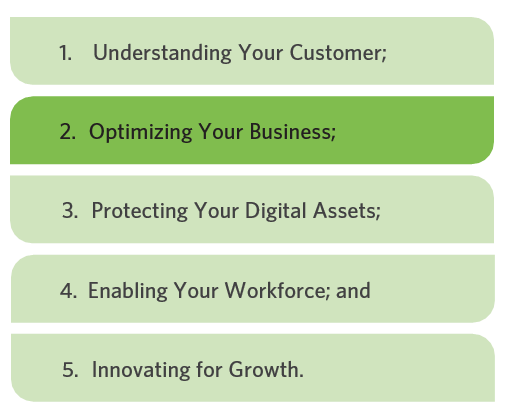Digitally Driving Business Outcomes (A 5 Part Series): – Part 2: Optimizing Your Business
A Five-Part Series
The last 16 months of dramatic change driven by the global COVID-19 pandemic has placed a spotlight on key business outcomes and accelerated Digital Transformation in Architecture and Engineering (A&E) firms. Each of these outcomes, coupled with how people and processes can be empowered digitally through the application of technologies, will be explored in this five-part series for firms. The series aims to provide insights into the five critical business outcomes:

Part 2: Optimizing Your Business
With the pace of business and development of deliverables, keeping tight control of operations within A&E firms is mission critical as efficiency correlates directly to the bottom line. In a year of unprecedented change, the industry is seeing an even greater push for digital enablement and business optimization. The ability for firms to adopt digital strategies and tools that will provide standardization in processes, collaboration and 360-degree visibility into projects, will help maximize productivity, improve efficiencies, increase profitability, and drive business success.
Architecture and engineering services require significant resources and planning with the end goal to deliver successful projects on time and on budget. With talent as a key asset, evaluating roles required and mobilizing your employees to align with skills sets needed along the value chain will eliminate unnecessary downtime and mistakes and maximize results.
Evaluating the underlying processes that drive a firm’s supply chain from bid to cash and beyond, will assist in mapping out key practices to standardize workflows, eliminate redundancies, and magnify opportunities to automate business practices. By implementing digital technologies like Nintex, firms can automate and standardize workflows and digitize forms resulting in collaboration, reduction in waste and errors, and will facilitate collecting the right data in real-time.
Mapping out employee roles, business processes and regulations and understanding the value chain from start to finish will further define the proper technology strategy and architecture for firms. Cloud, virtualization technologies and robust design and modeling programs enable a mobilized and collaborative workforce that can deliver on projects and ensure peak performance. Building Information Modeling (BIM) has created enormous opportunities for firms to supply data for downstream applications. Clients now look to firms to supply datasets as part of deliverables for facilities management to measure and improve facilities quantitatively and gain a wholistic assessment of performance. Further leveraging and automating data, firms can easily search and access office costs, registrations, lease agreements, space planning, etc., in a centralized manner versus referring to disparate data sources. Capturing real-time data and leveraging visual analytics platforms like Tableau or Power BI are transforming how architects, engineers and clients use data to solve problems.
By optimizing your talent, processes and technologies, firms can design and deliver better, faster and safer projects with greater efficiency, saving time and ultimately improving the bottom line.
Related Guidance:
- Digitally Driving Business Outcomes (A 5 Part Series) – Part I: Understanding Your Customer
- Digitally Driving Business Outcomes (A 5 Part Series) – Part 3: Protecting Your Digital Assets
- Digitally Driving Business Outcomes (A 5 Part Series) – Part 4: Enabling Your Workforce
- Digitally Driving Business Outcomes (A 5 Part Series) – Part 5: Innovating for Growth
